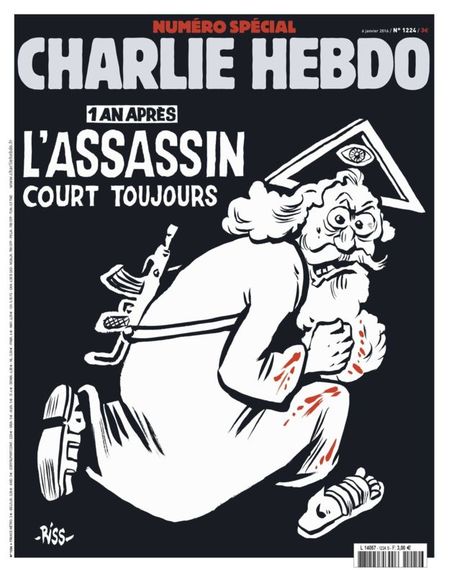
Popular French satirical magazine Charlie Hebdo, which was attacked by terrorists last year on grounds of publicly disrespecting Islam, has once again made the headlines. On the anniversary of the attack that killed most of the staff in its Paris office, the weekly published a controversial special edition featuring on its cover a sketch of a bearded, bloodstained God-like feature in sandals with a Kalashnikov slung over his shoulder, accompanied by the headline, "One year on: the killer is still at large". The Vatican has raised strong objections to the depiction, triggering yet another debate on the magazine's brand of satire.
Ever since Charlie Hebdo's inception, the world has been polarised about whether the highly controversial written and graphical content of the magazine is racist and bigoted against religion and the religious, or simply exercising the right to freedom of speech and expression.
Charlie has continued to attract ire, working from ultra-secure offices in a top-secret location and refusing to mellow down in the wake of the attacks.
A Vatican newspaper panned the cover for failing to "acknowledge or to respect believers' faith in God, regardless of the religion." "Behind the deceptive flag of uncompromising secularism, the weekly is forgetting once more what religious leaders of every faith unceasingly repeat...using God to justify hatred -- is a genuine blasphemy, as Pope Francis has said several times."
The magazine's fiercely secular content has in the past drawn the flak of believers of different religions. Its provocative drawings of Prophet Mohammed drew the fury of Muslims around the world and inspired the bloody attack on its offices on 7 January 2015. Prior to this, the magazine was firebombed in 2011.
Jihadist brothers Said and Cherif Kouachi shot eight Charlie staff as well as several others in and around the building in the assault, which started three days of terror in Paris. The terrorists also launched attacks on French police and the Jewish Hyper Cacher supermarket, leaving 17 dead.
The attacks, however, could not dampen the spirit of the publication, which continued with its no-holds-barred style.
"It is the idea of God itself that we, at Charlie, contest. You need to shake up people's ideas or they stay stuck in their positions," says cartoonist Riss, who lost a portion of his right arm in the attack. Riss in the editorial of the special edition wrote, "It was unthinkable that in France in the 21st century, journalists would be killed by religion. We saw France as an island of secularism, where it was possible to tell jokes, draw, laugh, without worrying about dogma, fanatics."
Charlie Hebdo, thus far a struggling publication, gained bittersweet fame after the attacks amidst mixed reactions of people around the world. It became a symbol of freedom of speech overnight, with the the hashtag JeSuisCharlie (I am Charlie) trending wildly; the magazine has printed one million copies of the anniversary edition.
Meanwhile, France again witnessed terror in November 2015 when 130 people were killed in coordinated attacks in and around Paris.
Undaunted, Charlie has continued to attract ire, working from ultra-secure offices in a top-secret location and refusing to mellow down in the wake of the attacks. When the magazine published a cartoon of Alan Kurdi, the Syrian toddler found dead on a Turkish beach last year, under a McDonald's sign in what was intended to be a critique of consumerism, there was considerable ire against the magazine.
However, other commentators pointed out that disturbing as the cartoon was, it was satire intended to draw attention to a problem and not meant to mock the little boy who lost his life.
So, perspectives differ when seen from different angles; whether Charlie is "racist" or secular depends on the perspective in question. However, the "never say die" attitude of the magazine is indeed commendable and inspirational. As Riss wrote in the aforementioned editorial, "It is not two little idiots in balaclavas who are going to screw up our life's work. It is not they who will kill Charlie, it is Charlie who will see them die."